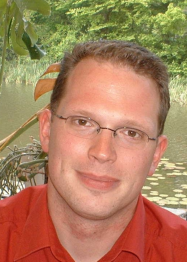Polymeric microring resonator based electro-optic modulator
Promotion Date: 27 May 2005
| The aim of my thesis was to develop a device to transfer digital signals into optical signals. For that purpose we used a microring in which the light that you guide into it resonates under certain conditions, depending on the wavelength (colour) of light. The light can exit at an output waveguide when the ring is in resonance. This resonance condition depends on the shape of the ring, in other words, with a slight alteration of the ring shape you can manipulate the amount of light that exits, varying from 100% to nothing, e.g ON or OFF, 1 or 0. |
What was your thesis about?
The aim of my thesis was to develop a device to transfer digital signals into optical signals. For that purpose we used a microring in which the light that you guide into it resonates under certain conditions, depending on the wavelength (colour) of light.
The light can exit at an output waveguide when the ring is in resonance. This resonance condition depends on the shape of the ring, in other words, with a slight alteration of the ring shape you can manipulate the amount of light that exits, varying from 100% to nothing, e.g ON or OFF, 1 or 0.
So your device works?
We managed to realize a working device that showed high frequency modulation. At this stage it is as yet not as reliable as you could wish; it doesn’t always work. It is all still at a very investigative stage. The optimalization which is easily 90% -as opposed to the research of 10% - still has to be done, and is not alltogether a researcher’s job.
Is this going to be the future thing to transfer digital signals into optical signals?
Probably not in this configuration, there are many ways in which you could do it, each with their own advantages and disadvantages. My device has the advantage of being very small, but the fabrication process is extremely critical.
But do you think yours is going to be the winning technology?
Perhaps No in the case of transferring 1and 0’s into optical signals, but perhaps Yes in the case of switching technologies and distribution of data.
Is the application of this ring new?
No, the ring has been used before and the resonator principle is used fairly frequently in IC-technology. My project involved the actual creation of the device from A to Z, without the help of a technician. And I applied a super low cost material, a polymer, which is new. For that I worked in the IST project NAIS (Next generation Active Integrated Subsystems) where a new polymer with exactly the characteristics I needed was developed. This was a European project, with several groups throughout Europe working together.
Did you enjoy the work in the clean room?
I did. I am not a person who can spend 40 hours per week behind a computer. I liked the actual construction work. The combination of design and creation of the actual device was the thing I enjoyed most about my research. At the beginning the construction part worried me a bit, but then it gave me thorough insight in the structure of my own design. So it turned out to be an advantage. Polymer technology is not a ‘forgiving technology’: everything has to be exactly right from the start, no corrections possible as for instance in glass like materials.
But how did you acquire the skill?
A lot of trial and error. And when employees from the AKZO subdivision JDS Uniface came to work here, I benefited from their extensive knowledge of polymer processing.
Any moments of despair over the past four years?
The first year when I absolutely did not have the slightest notion of polymers. The fact that JDS stopped and a lot of people started work here at Twente University was my rescue. A polymer is a very temperamental material, you could call it a living material – you really have to learn to handle it.
What are you going to do?
I have a job. In fact, next door.
I have started work with Lionix, a MESA+ spin off company.
For the summary of the thesis, click here.
Voor de samenvatting van het proefschrift, click hier.

